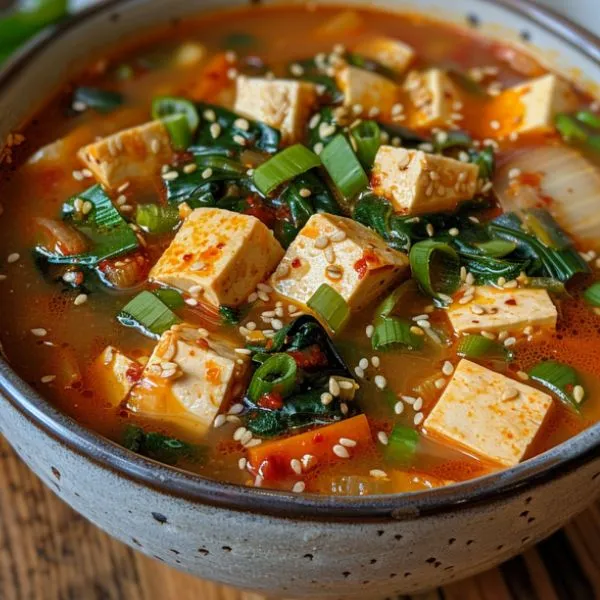Korean cuisine is known for its bold flavors, rich history, and healthful ingredients. One standout dish that embodies these qualities is Homemade Korean Tofu Soup, also known as Sundubu-jjigae. This comforting soup is a staple in Korean households and is celebrated for its warming, spicy, and umami-rich profile. With its delicate silken tofu and robust broth, it’s a dish that will tantalize your taste buds and provide a wholesome meal for any occasion.
The History of Korean Tofu Soup
Sundubu-jjigae, or Korean Tofu Soup, has roots deeply embedded in Korean culinary traditions. The dish became popular during the Joseon Dynasty and has evolved over the centuries, integrating various regional ingredients and flavors. Originally a humble meal for common folk, it has now become a beloved comfort food enjoyed by people from all walks of life. The use of fermented soybean paste (doenjang) and Korean red pepper flakes (gochugaru) gives the soup its distinctive taste, making it a quintessential part of Korean gastronomy.
Ingredients
To create an authentic Homemade Korean Tofu Soup, you’ll need the following ingredients:
- 1 tablespoon sesame oil
- 4 cloves garlic, minced
- 1 onion, diced
- 2 tablespoons Korean red pepper flakes (gochugaru)
- 1 tablespoon Korean fermented soybean paste (doenjang)
- 4 cups vegetable broth
- 1 package silken tofu, cut into cubes
- 1 cup mushrooms, sliced
- 1 zucchini, sliced
- 1/2 cup kimchi, chopped
- 1 teaspoon sugar
- Salt to taste
- 2 green onions, chopped
- 1 egg (optional)
These ingredients are not only flavorful but also packed with nutrients, making this soup a healthy choice for any meal.
Step-by-Step Instructions
1. Preparing the Aromatics
Start by heating 1 tablespoon of sesame oil in a large pot over medium heat. Once the oil is hot, add the 4 minced garlic cloves and 1 diced onion. Sauté these ingredients until they become fragrant and start to soften. This will form the aromatic base of your soup, imparting a rich, savory flavor.
2. Adding the Spices and Paste
Next, stir in 2 tablespoons of Korean red pepper flakes (gochugaru) and 1 tablespoon of Korean fermented soybean paste (doenjang). Cook these for about 1-2 minutes, allowing the flavors to meld and become fragrant. This step is crucial as it builds the foundational taste of your soup, with the gochugaru providing a spicy kick and the doenjang adding depth and umami.
3. Building the Broth
Pour in 4 cups of vegetable broth into the pot, stirring well to combine with the aromatics and spices. Bring the mixture to a boil. The vegetable broth will carry the flavors of the garlic, onion, gochugaru, and doenjang, creating a rich and robust soup base.
4. Simmering the Vegetables and Tofu
Once the broth is boiling, lower the heat and add the silken tofu cubes, sliced mushrooms, sliced zucchini, and chopped kimchi. Gently simmer these ingredients for about 10 minutes. The tofu will absorb the flavorful broth, while the mushrooms and zucchini will add texture and earthiness to the soup. The kimchi will contribute a tangy, fermented flavor that complements the other ingredients beautifully.
5. Seasoning the Soup
Season the soup with 1 teaspoon of sugar and salt to taste. The sugar balances the spiciness and acidity of the soup, creating a well-rounded flavor profile. Adjust the seasoning according to your preference, ensuring that the soup is savory and satisfying.
6. Optional Egg Addition
If you prefer, you can crack an egg into the center of the soup just before serving. Let it poach gently in the hot broth until it reaches your desired level of doneness. The egg adds a creamy texture and additional protein, making the soup even more hearty and filling.
7. Garnishing and Serving
Finally, garnish your Homemade Korean Tofu Soup with chopped green onions. The fresh green onions add a burst of color and a subtle crunch that enhances the overall presentation and taste of the soup.
Serving Suggestions
Homemade Korean Tofu Soup is best enjoyed hot and fresh. Serve it with a side of steamed rice to balance the spiciness of the soup. You can also pair it with various Korean side dishes (banchan) such as kimchi, pickled radishes, and seasoned vegetables. This soup makes a perfect meal for chilly days or whenever you crave something warm and comforting.
Health Benefits
This soup is not only delicious but also highly nutritious. The silken tofu provides a good source of protein and is low in calories. The vegetables and kimchi are rich in vitamins, minerals, and probiotics, which support digestive health. Additionally, the use of vegetable broth makes this soup suitable for vegetarians and vegans.
Conclusion
Homemade Korean Tofu Soup is a delightful dish that brings together the best of Korean flavors and nutrition. Its simplicity and depth of flavor make it a favorite for many. Whether you are new to Korean cuisine or a seasoned enthusiast, this soup is sure to become a staple in your culinary repertoire.
